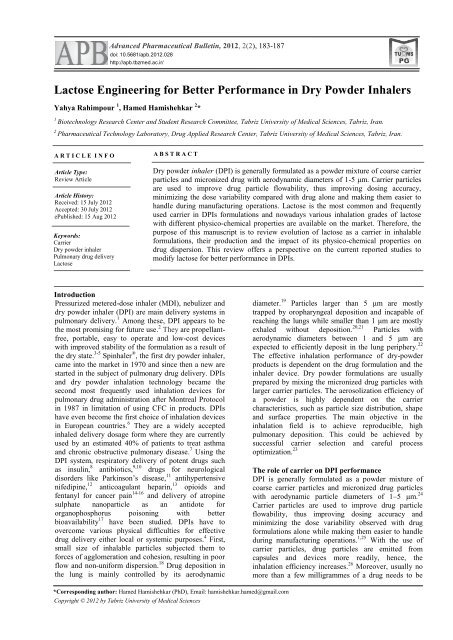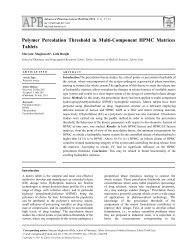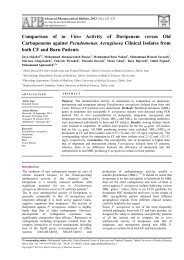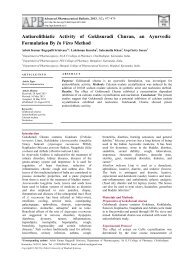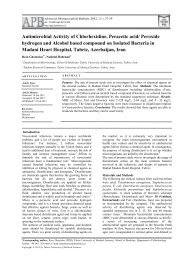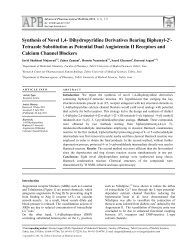Download as PDF - Advanced Pharmaceutical Bulletin
Download as PDF - Advanced Pharmaceutical Bulletin
Download as PDF - Advanced Pharmaceutical Bulletin
Create successful ePaper yourself
Turn your PDF publications into a flip-book with our unique Google optimized e-Paper software.
<strong>Advanced</strong> <strong>Pharmaceutical</strong> <strong>Bulletin</strong>, 2012, 2(2), 183-187<br />
doi: 10.5681/apb.2012.028<br />
http://apb.tbzmed.ac.ir/<br />
Lactose Engineering for Better Performance in Dry Powder Inhalers<br />
Yahya Rahimpour 1 , Hamed Hamishehkar 2 *<br />
1<br />
Biotechnology Research Center and Student Research Committee, Tabriz University of Medical Sciences, Tabriz, Iran.<br />
2<br />
<strong>Pharmaceutical</strong> Technology Laboratory, Drug Applied Research Center, Tabriz University of Medical Sciences, Tabriz, Iran.<br />
A R T I C L E I N F O<br />
Article Type:<br />
Review Article<br />
Article History:<br />
Received: 15 July 2012<br />
Accepted: 30 July 2012<br />
ePublished: 15 Aug 2012<br />
Keywords:<br />
Carrier<br />
Dry powder inhaler<br />
Pulmonary drug delivery<br />
Lactose<br />
A B S T R A C T<br />
Dry powder inhaler (DPI) is generally formulated <strong>as</strong> a powder mixture of coarse carrier<br />
particles and micronized drug with aerodynamic diameters of 1-5 μm. Carrier particles<br />
are used to improve drug particle flowability, thus improving dosing accuracy,<br />
minimizing the dose variability compared with drug alone and making them e<strong>as</strong>ier to<br />
handle during manufacturing operations. Lactose is the most common and frequently<br />
used carrier in DPIs formulations and nowadays various inhalation grades of lactose<br />
with different physico-chemical properties are available on the market. Therefore, the<br />
purpose of this manuscript is to review evolution of lactose <strong>as</strong> a carrier in inhalable<br />
formulations, their production and the impact of its physico-chemical properties on<br />
drug dispersion. This review offers a perspective on the current reported studies to<br />
modify lactose for better performance in DPIs.<br />
Introduction<br />
Pressurized metered-dose inhaler (MDI), nebulizer and<br />
dry powder inhaler (DPI) are main delivery systems in<br />
pulmonary delivery. 1 Among these, DPI appears to be<br />
the most promising for future use. 2 They are propellantfree,<br />
portable, e<strong>as</strong>y to operate and low-cost devices<br />
with improved stability of the formulation <strong>as</strong> a result of<br />
the dry state. 3-5 Spinhaler ® , the first dry powder inhaler,<br />
came into the market in 1970 and since then a new are<br />
started in the subject of pulmonary drug delivery. DPIs<br />
and dry powder inhalation technology became the<br />
second most frequently used inhalation devices for<br />
pulmonary drug administration after Montreal Protocol<br />
in 1987 in limitation of using CFC in products. DPIs<br />
have even become the first choice of inhalation devices<br />
in European countries. 6 They are a widely accepted<br />
inhaled delivery dosage form where they are currently<br />
used by an estimated 40% of patients to treat <strong>as</strong>thma<br />
and chronic obstructive pulmonary dise<strong>as</strong>e. 7 Using the<br />
DPI system, respiratory delivery of potent drugs such<br />
<strong>as</strong> insulin, 8 antibiotics, 9,10 drugs for neurological<br />
disorders like Parkinson’s dise<strong>as</strong>e, 11 antihypertensive<br />
nifedipine, 12 anticoagulant heparin, 13 opioids and<br />
fentanyl for cancer pain 14-16 and delivery of atropine<br />
sulphate nanoparticle <strong>as</strong> an antidote for<br />
organophosphorus poisoning with better<br />
bioavailability 17 have been studied. DPIs have to<br />
overcome various physical difficulties for effective<br />
drug delivery either local or systemic purposes. 4 First,<br />
small size of inhalable particles subjected them to<br />
forces of agglomeration and cohesion, resulting in poor<br />
flow and non-uniform dispersion. 18 Drug deposition in<br />
the lung is mainly controlled by its aerodynamic<br />
diameter. 19 Particles larger than 5 μm are mostly<br />
trapped by oropharyngeal deposition and incapable of<br />
reaching the lungs while smaller than 1 μm are mostly<br />
exhaled without deposition. 20,21 Particles with<br />
aerodynamic diameters between 1 and 5 μm are<br />
expected to efficiently deposit in the lung periphery. 22<br />
The effective inhalation performance of dry-powder<br />
products is dependent on the drug formulation and the<br />
inhaler device. Dry powder formulations are usually<br />
prepared by mixing the micronized drug particles with<br />
larger carrier particles. The aerosolization efficiency of<br />
a powder is highly dependent on the carrier<br />
characteristics, such <strong>as</strong> particle size distribution, shape<br />
and surface properties. The main objective in the<br />
inhalation field is to achieve reproducible, high<br />
pulmonary deposition. This could be achieved by<br />
successful carrier selection and careful process<br />
optimization. 23<br />
The role of carrier on DPI performance<br />
DPI is generally formulated <strong>as</strong> a powder mixture of<br />
coarse carrier particles and micronized drug particles<br />
with aerodynamic particle diameters of 1–5 μm. 24<br />
Carrier particles are used to improve drug particle<br />
flowability, thus improving dosing accuracy and<br />
minimizing the dose variability observed with drug<br />
formulations alone while making them e<strong>as</strong>ier to handle<br />
during manufacturing operations. 1,25 With the use of<br />
carrier particles, drug particles are emitted from<br />
capsules and devices more readily, hence, the<br />
inhalation efficiency incre<strong>as</strong>es. 26 Moreover, usually no<br />
more than a few milligrammes of a drug needs to be<br />
*Corresponding author: Hamed Hamishehkar (PhD), Email: hamishehkar.hamed@gmail.com<br />
Copyright © 2012 by Tabriz University of Medical Sciences
Rahimpour and Hamishehkar<br />
delivered (e.g., between 20 μg and 500 μg of<br />
corticosteroids for <strong>as</strong>thma therapy), and thus carrier<br />
provides bulk, which improves the handling,<br />
dispensing, and metering of the drug. 23 The presence of<br />
the carrier material is the t<strong>as</strong>te/sensation on inhaling,<br />
which can <strong>as</strong>sure the patient that a dose h<strong>as</strong> been<br />
taken. 4 Consequently, the carrier forms an important<br />
component of the formulation and any change in the<br />
physico-chemical properties of the carrier particles h<strong>as</strong><br />
the potential to alter the drug deposition profile. 27<br />
Therefore, the design of the carrier particle is important<br />
for the development of DPIs. 28 Carrier particles should<br />
have several characteristics such <strong>as</strong> physico-chemical<br />
stability, biocompatibility and biodegradability,<br />
compatible with the drug substance and must be inert,<br />
available and economical. During insufflation, the drug<br />
particles are detached from the surface of the carrier<br />
particles by the energy of the inspired air flow that<br />
overcomes the adhesion forces between drug and<br />
carrier. The larger carrier particles impact in the upper<br />
airways, while the small drug particles go through the<br />
lower parts of lungs. 23 Unsatisfactory detachment of<br />
drug from the carrier due to strong inter-particulate<br />
forces may be one of the main re<strong>as</strong>ons of inefficient<br />
drug delivery encountered with most DPIs. 29,30<br />
Therefore, in the best c<strong>as</strong>e, the adjusted balance<br />
between adhesive and cohesive forces provides enough<br />
adhesion between drug and carrier to produce a stable<br />
formulation (homogeneous mixture with no powder<br />
segregation and proper content uniformity) yet allows<br />
for e<strong>as</strong>y separation during inhalation. Consequently, it<br />
h<strong>as</strong> been stated that the efficiency of a DPI formulation<br />
is extremely dependent on the carrier characteristics<br />
and the selection of carrier is a crucial determinant of<br />
the overall DPI performance. 23 Obviously, the effect of<br />
the carrier material on DPI formulation should be<br />
carefully evaluated. The range of materials which can<br />
be proposed to be <strong>as</strong> carriers in inhaled products are<br />
restricted for toxicological re<strong>as</strong>ons. Lactose and other<br />
sugars have been studied and used, therefore<br />
modifications to these materials may allow further<br />
formulation optimization. 4<br />
Lactose <strong>as</strong> the most frequently used carrier in DPIs<br />
Lactose, 4-(b-D-galactosido-)-D-glucose, can be<br />
obtained in either two b<strong>as</strong>ic isomeric forms, α and β-<br />
lactose, or <strong>as</strong> an amorphous form. 31 Historically,<br />
lactose monohydrate w<strong>as</strong> an obvious choice for use <strong>as</strong> a<br />
carrier excipient. Lactose accompanying with glucose<br />
and mannitol is allowed <strong>as</strong> carriers in DPIs by the US<br />
Food and Drug Administration department. 32 Lactose is<br />
the most common and frequently used carrier in DPI<br />
formulations accordingly nowadays various inhalation<br />
grades of lactose with different physico-chemical<br />
properties are available on the market. The advantages<br />
of lactose are its well-investigated toxicity profile,<br />
physical and chemical stability, compatibility with the<br />
drug substance, its broad availability and relatively low<br />
price. 33,34 α-lactose monohydrate is the most common<br />
lactose grade used in the inhalation field. Almost all<br />
DPI formulations on the market are b<strong>as</strong>ed on α-lactose<br />
monohydrate <strong>as</strong> a carrier. Therefore, wealth of<br />
literatures refers to the optimization of lactose carrier<br />
particles for better inhalation performance. More than<br />
250 articles have been published in the p<strong>as</strong>t 40 years<br />
regarding the role of lactose in adhesive mixtures used<br />
in DPIs. However, in spite of these extensive<br />
investigations, the relationship between physicochemical<br />
properties of the lactose in adhesive mixtures<br />
and the performance of the DPIs remains largely<br />
indistinct. 6<br />
Lactose engineering for application in DPIs<br />
Surface modification<br />
Iida et al. prepared lactose carrier particles for dry<br />
powder inhalations by its surface modification with<br />
aqueous ethanol solution and evaluated the inhalation<br />
efficiency of salbutamol sulfate from its mixture with<br />
modified lactose. The degree of adhesion between drug<br />
particles and carrier particles and the separation<br />
characteristics of drug particles from carrier particles in<br />
air flow were <strong>as</strong>sessed by the ultracentrifuge separation<br />
and the air jet sieve methods, respectively. It w<strong>as</strong><br />
shown that the average adhesion force between the<br />
surface-treated lactose carrier and drug particles w<strong>as</strong><br />
considerably lower than that of powder mixed with the<br />
un-treated lactose carrier, indicating better drug<br />
separation from carrier and consequently an<br />
improvement of in vitro inhalation properties. The<br />
authors claimed that surface-smoothing of lactose by<br />
aqueous ethanol solution resulted a well balanced drugcarrier<br />
adhesion force so that the drug particles could<br />
be emitted together with the carrier particles and<br />
efficiently separated in airflow after emission. 35 Fine<br />
lactose particles were immobilized on the lactose<br />
surface by spray coating with liquid suspensions<br />
consisting of micronized lactose dispersed in isopropyl<br />
alcohol and/or water mixtures to modify surface of<br />
lactose. The produced lactose w<strong>as</strong> used <strong>as</strong> a carrier in<br />
the formulation of inhalable salbutamol sulfate powder.<br />
It w<strong>as</strong> found that the roughness of the lactose surface<br />
established by immobilization of fine lactose incre<strong>as</strong>ed<br />
the FPF and dispersibility of the drug. The authors<br />
claimed that unlike crevices and valleys, these<br />
microscopic undulations did not accommodate the drug<br />
particles and instead enhanced the detachment of drug<br />
from the lactose surface and improved the drug<br />
inhalation efficiency. 36 Spray dried amorphous, spray<br />
dried crystallized and fluidized bed granulated lactose<br />
were prepared and used <strong>as</strong> carrier for inhalation of<br />
pranluk<strong>as</strong>t hydrate. Fluidized bed granulated lactose<br />
emitted drug particles effectively from the inhalation<br />
device, where<strong>as</strong> most part of drug captured in the upper<br />
stage of twin impinger, resulting in lower inhalation<br />
efficiency, due to strong adhesion of drug to the carrier<br />
lactose. The spray dried amorphous lactose, smoothed<br />
sphere particle, did not so improve the inhalation<br />
efficiency <strong>as</strong> expected, because of fairly strong<br />
184 |<br />
<strong>Advanced</strong> <strong>Pharmaceutical</strong> <strong>Bulletin</strong>, 2012, 2(2), 183-187<br />
Copyright © 2012 by Tabriz University of Medical Sciences
Lactose Engineering for Inhalable Formulations<br />
adhesion between drug and lactose particles. But the<br />
spray dried crystallized lactose having lots of<br />
microscopical projection on its surface incre<strong>as</strong>ed the<br />
respirable particle percent of the emitted particles. The<br />
conclusion w<strong>as</strong> that the surface roughness should be<br />
optimized to gain improved inhalation efficiency of<br />
particles. 37 In the other study, a Wurster fluidized bed<br />
w<strong>as</strong> used for surface-coating of lactose particles with<br />
lactose aqueous solution containing hydroxypropyl<br />
methyl cellulose. The authors could be able to incre<strong>as</strong>e<br />
the inhalation performance of salbutamol sulfate 2.5<br />
times more than commercial lactose<br />
(Pharmatose ® 200M) and reported that surface coating<br />
of carrier particles may be an effective technique for<br />
improving the inhalation performance of DPI. 38<br />
Lactose carrier particles were layered with vegetable<br />
magnesium stearate by physical mixing and their effect<br />
of on the dry powder inhalation properties of<br />
salbutamol sulfate w<strong>as</strong> investigated. The in vitro<br />
inhalation performance of drug w<strong>as</strong> enhanced<br />
compared with the powder mixed with unlayered<br />
lactose carrier. It w<strong>as</strong> stated that using this surface<br />
layering system would thus be valuable for incre<strong>as</strong>ing<br />
the inhalation properties of dry powder inhalation. 39<br />
For example, incre<strong>as</strong>ing the surface smoothness of<br />
lactose carrier particles w<strong>as</strong> shown to improve the<br />
potentially respirable fraction of albuterol sulfate from<br />
the Rotahaler ® . 40<br />
Shape modification<br />
Lactose crystallization from Carbopol gel in different<br />
conditions (named Carbo lactose) produced a more<br />
regular shape lactose with smoother surface <strong>as</strong><br />
compared with the control lactose. The Carbo lactose<br />
caused a higher and reproducible salbutamol sulphate<br />
emission and fine particle fraction after aerosolisation<br />
via a Rotahaler ® tested in multi-stage impinge. It w<strong>as</strong><br />
concluded that engineered crystal growth under<br />
controlled conditions can enhance the potential<br />
inhalable fraction of drug from dry powder inhalers. 41<br />
More recently, the use of more elongated crystals of<br />
lactose w<strong>as</strong> also found to produce a higher inhalation<br />
efficiency of albuterol sulfate. 29 However, the<br />
improvement in drug dispersion that can be achieved<br />
by incre<strong>as</strong>ing the elongation ratio of the carrier<br />
particles is limited. 42<br />
Composite lactose<br />
Lactose carrier particles were prepared by fusing sub<br />
units of lactose (either 2, 6 or 10 μm prepared by spray<br />
drying) in saturated lactose slurry, sieve fractioned to<br />
obtain a 63–90 μm carriers and used for inhalation of<br />
salbutamol sulfate. The surface morphology and<br />
physico-chemical properties of the composite carriers<br />
were considerably different from regular α-lactose<br />
monohydrate. In all c<strong>as</strong>es, the composite carriers<br />
resulted in improved drug aerosol performance. It w<strong>as</strong><br />
suggested that composite b<strong>as</strong>ed carriers are a potential<br />
route to control drug-carrier adhesion forces and<br />
variability thus allowing more precise control of<br />
formulation performance. 43<br />
Engineered lactose-mannitol mixture<br />
Mannitol and lactose were co-crystallised to prepare<br />
crystals with more desirable characteristics than either<br />
lactose or mannitol alone appropriate for application <strong>as</strong><br />
carriers in the formulations of salbutamol sulfate DPIs.<br />
In vitro deposition evaluation showed that crystallized<br />
carriers resulted more efficient delivery of salbutamol<br />
sulphate compared to formulations containing<br />
commercial grade carriers. It w<strong>as</strong> concluded that<br />
simultaneous crystallization of lactose-mannitol can be<br />
a new approach to enhance inhalation performance of<br />
DPI formulations. 44<br />
Expert Opinion and Final Remarks<br />
Interest in DPIs h<strong>as</strong> incre<strong>as</strong>ed in the l<strong>as</strong>t decade due to<br />
its numerous advantages over other pulmonary drug<br />
delivery dosage forms. Currently, the inhalation<br />
performance of DPIs are being improved by changing<br />
formulation strategy, drug and carrier particle<br />
engineering. Regarding formulation development,<br />
micronized drug particles are cohesive with poor flow<br />
properties. Addition of large carrier particles, mostly<br />
lactose, into powders to enhance their flow<br />
characteristics h<strong>as</strong> been an appropriate approach. The<br />
main goal in the inhalation field is to obtain<br />
reproducible, high pulmonary deposition which can be<br />
highly effected by physico-chemical characteristics of<br />
lactose. Technologies for engineering lactose particle<br />
shape, density, and size will continue to develop to<br />
enhance the effectiveness of pulmonary drug<br />
formulations. This approach may enable more drugs to<br />
be delivered through this route for local treatment of<br />
lung dise<strong>as</strong>es or systemic therapy.<br />
References<br />
1. Timsina MP, Martin GP, Marriott C, Ganderton D,<br />
Yianneskis M. Drug delivery to the respiratory tract<br />
using dry powder inhalers. Int J Pharm 1994;101(1-<br />
2):1-13.<br />
2. Todo H, Okamoto H, Iida K, Danjo K. Effect of<br />
additives on insulin absorption from intratracheally<br />
administered dry powders in rats. Int J Pharm<br />
2001;220:101-10.<br />
3. Carpenter JF, Pikal MJ, Chang BS, Randolph TW.<br />
Rational design of stable lyophilized protein<br />
formulations: some practical advice. Pharm Res<br />
1997;14:969-75.<br />
4. Prime D, Atkins PJ, Slater A, Sumby B. Review of<br />
dry powder inhalers. Adv Drug Deliv Rev<br />
1997;26(1):51-8.<br />
5. Hamishehkar H, Emami J, Najafabadi AR, Gilani<br />
K, Minaiyan M, Mahdavi H, et al. Influence of<br />
carrier particle size, carrier ratio and addition of fine<br />
ternary particles on the dry powder inhalation<br />
performance of insulin-loaded PLGA<br />
microcapsules. Powder Technol 2010;201: 289-95.<br />
Copyright © 2012 by Tabriz University of Medical Sciences<br />
<strong>Advanced</strong> <strong>Pharmaceutical</strong> <strong>Bulletin</strong>, 2012, 2(2), 183-187 | 185
Rahimpour and Hamishehkar<br />
6. Marriott C, Frijlink HW. Lactose <strong>as</strong> a carrier for<br />
inhalation products: breathing new life into an old<br />
carrier. Adv Drug Deliv Rev 2012;64(3):217-9.<br />
7. Atkins PJ. Dry powder inhalers: an overview. Resp<br />
Care 2005;50(10):1304-12.<br />
8. Hamishehkar H, Emami J, Najafabadi AR, Gilani<br />
K, Minaiyan M, H<strong>as</strong>sanzadeh K, et al.<br />
Pharmacokinetics and pharmacodynamics of<br />
controlled rele<strong>as</strong>e insulin loaded PLGA<br />
microcapsules using dry powder inhaler in diabetic<br />
rats. Biopharm Drug Dispos 2010;31(2-3):189-201.<br />
9. Geller DE, Konstan WK, Smith J, Noonberg SB,<br />
Conrad C. Novel tobramycin inhalation powder in<br />
cystic fibrosis subjects: pharmacokinetics and<br />
safety. Pediatr Pulm 2007;42:307-13.<br />
10. Hickey AJ, Lu D, Ashley ED, Stout J. Inhaled<br />
azithromycin therapy. J Aerosol Med 2006;19:54-<br />
60.<br />
11. Stoessl AJ. Potential therapeutic targets for<br />
Parkinson’s dise<strong>as</strong>e. Expert Opin Ther Tar<br />
2008;12:425-36.<br />
12. Plumley C, Gorman EM, El-Gendy N, Bybee CR,<br />
Munson EJ, Berkland C. Nifedipine nanoparticle<br />
agglomeration <strong>as</strong> a dry powder aerosol formulation<br />
strategy. Int J Pharm 2009;369(1-2):136-43.<br />
13. Rawat A, Majumder QH, Ahsan F. Inhalable large<br />
porous microspheres of low molecular weight<br />
heparin: in vitro and in vivo evaluation. J Control<br />
Rele<strong>as</strong>e 2008;128(3):224-32.<br />
14. Farr SJ, Otulana BA. Pulmonary delivery of opioids<br />
<strong>as</strong> pain therapeutics. Adv Drug Deliv Rev.<br />
2006;58(9):1076-88.<br />
15. Kleinstreuer C, Zhang Z, Donohue JF. Targeted<br />
drug-aerosol delivery in the human respiratory<br />
system. Annu Rev Biomed Eng 2008;10:195-220.<br />
16. Fleischer W, Reimer K, Leyendecker P. Opioids for<br />
the treatment of the chronic obstructive pulmonary<br />
dise<strong>as</strong>e. Luxembourg: Euro-Celtique S.A; 2005.<br />
17. Ali R, Jain GK, Iqbal Z, Talegaonkar S, Pandit P,<br />
Sule S, et al. Development and clinical trial of nanoatropine<br />
sulfate dry powder inhaler <strong>as</strong> a novel<br />
organophosphorous poisoning antidote.<br />
Nanomedicine 2009;5(1):55-63.<br />
18. Crowder TM, Rosati JA, Schroeter JD, Hickey AJ,<br />
Martonen TB. Fundamental effects of particle<br />
morphology on lung delivery: Predictions of Stokes'<br />
law and the particular relevance to dry powder<br />
inhaler formulation and development. Pharm Res<br />
2002;19(3):239-45.<br />
19. Wolff RK, Dorato MA. Toxicologic testing of<br />
inhaled pharmaceutical aerosols. Crit Rev Toxicol<br />
1993;23:343-69.<br />
20. Sakagami M. In vivo, in vitro and ex vivo models to<br />
<strong>as</strong>sess pulmonary absorption and disposition of<br />
inhaled therapeutics for systemic delivery. Adv<br />
Drug Deliv Rev 2006;58(9):1030-60.<br />
21. Emami J, Hamishehkar H, Najafabadi AR, Gilani<br />
K, Minaiyan M, Mahdavi H, et al. Particle size<br />
design of PLGA microspheres for potential<br />
pulmonary drug delivery using response surface<br />
methodology. J Microencapsul 2009;26(1):1-8.<br />
22. Heyder J, Gebhart J, Rudolf G, Schiller CF,<br />
Stahlhofen W. Deposition of particles in the human<br />
respiratory tract in the size range 0.005 - 5 μm. J<br />
Aerosol Sci 1986;17(5):811-25.<br />
23. Pilcer G, Wauthoz N, Amighi K. Lactose<br />
characteristics and the generation of the aerosol.<br />
Adv Drug Deliv Rev 2012;64: 233-56.<br />
24. Iida K, Hayakawa Y, Okamoto H, Danjo K,<br />
Luenberger H. Effect of surface covering of lactose<br />
carrier particles on dry powder inhalation properties<br />
of salbutamol sulfate. Chem Pharm Bull<br />
2003;51(12):1455-7.<br />
25. Schiavone H, Palakodaty S, Clark A, York P,<br />
Tzannis ST. Evaluation of SCF-engineered particleb<strong>as</strong>ed<br />
lactose blends in p<strong>as</strong>sive dry powder inhalers.<br />
Int J Pharm 2004;281(1):55-66.<br />
26. Iida K, Hayakawa Y, Okamoto H, Danjo K,<br />
Leuenberger H. Evaluation of flow properties of dry<br />
powder inhalation of salbutamol sulfate with lactose<br />
carrier. Chem Pharm Bull 2001;49(10):1326-30.<br />
27. Zeng XM, Pandhal KH, Martin GP. The influence<br />
of lactose carrier on the content homogeneity and<br />
dispersibility of beclometh<strong>as</strong>one dipropionate from<br />
dry powder aerosols. Int J Pharm 2000;197:41-52.<br />
28. Hamishehkar H, Emami J, Najafabadi AR, Gilani<br />
K, Minaiyan M, Mahdavi H, et al. Effect of carrier<br />
morphology and surface characteristics on the<br />
development of respirable PLGA microcapsules for<br />
sustained-rele<strong>as</strong>e pulmonary delivery of insulin. Int<br />
J Pharm 2010;389(1-2):74-85.<br />
29. Zeng XM, Martin GP, Marriott C, Pritchard J. The<br />
influence of carrier morphology on drug delivery by<br />
dry powder inhalers. Int J Pharm 2000;200:93-106.<br />
30. Zhou QT, Morton DAV. Drug-lactose binding<br />
<strong>as</strong>pects in adhesive mixtures: controlling<br />
performance in dry powder Inhaler formulations by<br />
altering lactose carrier surfaces. Adv Drug Deliv<br />
Rev 2012;64(3):275-84.<br />
31. Zeng XM, Martin GP, Marriott C, Pritchrd J. The<br />
Influence of crystallization conditions on the<br />
morphology of lactose intended for use <strong>as</strong> a carrier<br />
for dry powder aerosols. J Pharm Pharmacol<br />
2000;52:633-43.<br />
32. Labiris NR, Dolovich MB. Pulmonary drug<br />
delivery. Part II: the role of inhalant delivery<br />
devices and drug formulations in therapeutic<br />
effectiveness of aerosolized medications. Br J Clin<br />
Pharmacol 2003;56(6):600-12.<br />
33. Steckel H, Bolzen N. Alternative sugars <strong>as</strong> potential<br />
carriers for dry powder inhalations. Int J Pharm<br />
2004;270(1):297-306.<br />
34. Pilcer G, Amighi K. Formulation strategy and use<br />
of excipients in pulmonary drug delivery. Int J<br />
Pharm 2010;392:1-19.<br />
35. Iida K, Hayakawa Y, Okamoto H, Danjo K,<br />
Leuenberger H. Preparation of dry powder<br />
186 |<br />
<strong>Advanced</strong> <strong>Pharmaceutical</strong> <strong>Bulletin</strong>, 2012, 2(2), 183-187<br />
Copyright © 2012 by Tabriz University of Medical Sciences
Lactose Engineering for Inhalable Formulations<br />
inhalation by surface treatment of lactose carrier<br />
particles. Chem Pharm Bull 2003;51(1):1-5.<br />
36. Chan LW, Lim LT, Heng PWS. Immobilization of<br />
fine particles on lactose carrier by precision coating<br />
and its effect on the performance of dry powder<br />
formulations. J Pharm Sci 2003;92(5):975-84.<br />
37. Kaw<strong>as</strong>hima Y, Serigano T, Hino T, Yamamoto H,<br />
Takeuchi H. Effect of surface morphology of carrier<br />
lactose on dry powder inhalation property of<br />
pranluk<strong>as</strong>t hydrate. Int J Pharm 1998;172(1):179-<br />
88.<br />
38. Iida K, Todo H, Okamoto H, Danjo K, Leuenberger<br />
H. Preparation of dry powder inhalation with<br />
lactose carrier particles surface-coated using a<br />
Wurster fluidized bed. Chem Pharm Bull<br />
2005;53(4):431-4.<br />
39. Iida K, Hayakawa Y, Okamoto H, Danjo K,<br />
Luenbergerb H. Effect of surface layering time of<br />
lactose carrier particles on dry powder inhalation<br />
properties of salbutamol sulfate. Chem Pharm Bull<br />
2004;52 (3):350-3.<br />
40. Littringer EM, Mescher A, Schroettner H, Achelis<br />
L, Walzel P, Urbanetz NA. Spray dried mannitol<br />
carrier particles with tailored surface properties –<br />
The influence of carrier surface roughness and<br />
shape. Eur J Pharm Biopharm 2012;82(1):194-204.<br />
41. Zeng XM, Martin GP, Marriott C, Pritchard J. The<br />
use of lactose recrystallised from carbopol gels <strong>as</strong> a<br />
carrier for aerosolised salbutamol sulphate. Eur J<br />
Pharm Biopharm 2001;51(1):55-62.<br />
42. Zeng XM, Martin GP, Marriott C, Pritchard J.<br />
Lactose <strong>as</strong> a carrier in dry powder formulations: the<br />
influence of surface characteristics on drug delivery.<br />
J Pharm Sci 2001;90(9):1424-34.<br />
43. Young PM, Kwok P, Adi H, Chan H-K, Traini D.<br />
Lactose composite carriers for respiratory delivery.<br />
Pharm Res 2009;26(4):802-10.<br />
44. Kaialy W, Larhrib H, Martin GP, Nokhodchi A.<br />
The effect of engineered mannitol-lactose mixture<br />
on dry powder inhaler performance. Pharm Res<br />
2012; 29(3):2139-56.<br />
Copyright © 2012 by Tabriz University of Medical Sciences<br />
<strong>Advanced</strong> <strong>Pharmaceutical</strong> <strong>Bulletin</strong>, 2012, 2(2), 183-187 | 187


